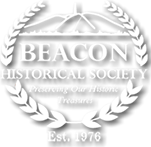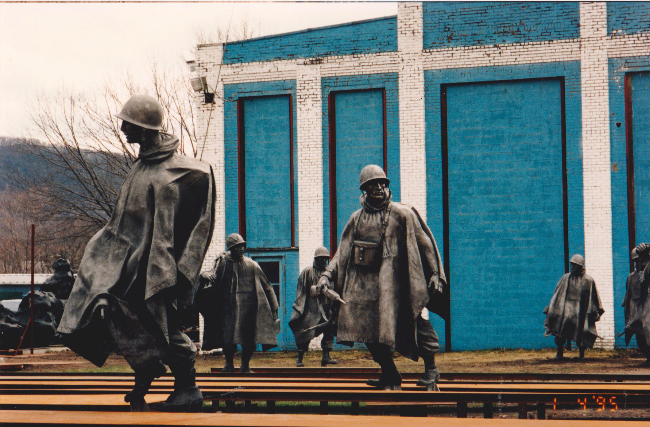Of Ponchos and Electric Flying Suits
Korean War Sculptures at Tallix Foundry, April 1995;
When artist Frank Gaylord of Barre, Vermont, sculpted in clay his nineteen soldiers for the Korean War Memorial in Washington, D.C., he clothed the American infantrymen in wind-blown ponchos to effect a symbolic representation of the cold, rainy-snowy miserable conditions those men experienced while fighting in Korea. What a coincidence, then, that the stainless steel, seven-foot-tall sculptures would be cast at the Tallix Foundry in Beacon--the very place where the real life counterparts to those clay ponchos would be manufactured during the Korean War. The factory that made the rain gear was the Bobrich Manufacturing Corporation located at One East Main Street
The Bobrich factory has an interesting history relating to the war effort at the home front. Incorporated about 1943, as an associated firm of the Debway Hat Company at One East Main, Bobrich jump started right into war production with the manufacture of electrically heated flying suits for the Army Air Force. By 1945, Bobrich employed about 700 workers (mostly women) sewing the clothing or assembling the electronics for the flying suits that would keep warm the American bomber crews in sub-zero flying temperatures. To maximize its workforce, Bobrich initiated a bold new policy that allowed otherwise home bound mothers to return to work. Management's solution to the manpower shortage during the war was to have an in-house nursery for young children two to six years old. The Debway-Bobrich companies' nursery was Beacon's first ever factory day care center--staffed with a nurse and complete with a playground next to the factory. And after World War II, when lucrative government contracts disappeared, Bobrich again acted creatively when it diversified production by the making of electric blankets for the peacetime market, a commodity that would be its mainstay for the next fifteen years.
Fast forward to 1952, with the Korean War in full involvement, Bobrich again secured another government contract--this one almost completely unrelated to its electronics-related manufacturing background ... the making of rain wear for the infantry. In July of 1952, sewing machine operators at Bobrich scurried to fill orders for 400,000 ponchos for the government! The rain gear, made of nylon and complete with a hood, was cut full-bodied, thus allowing the soldier to carry his firearm inside the coat dry and protected. The ponchos also were designed to be multi-purposed: to be used as a half sheet and blanket to a personal tent like shelter. Expert in service uniforms, Frank Gaylord outfitted his Korean soldiers all in ponchos, and thereby created a lasting bond between Beacon and the Korean War Memorial.
Anna Tomanic sews a poncho at Bobrich, 1952
Manual for F3-A Flying Suit made at Bobrich in 1945




